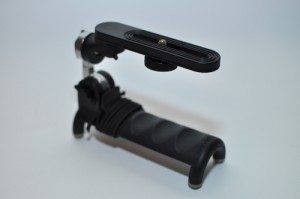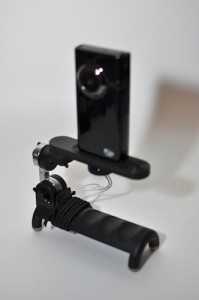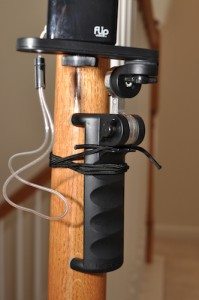 One of the first good “tricks” that budding photographers learn is that good, sharp pictures often require a tripod, or at the very least, require the photographer to brace him or herself against something solid to reduce camera shake. Unfortunately, this just isn’t possible in many situations, and otherwise good pictures are sometimes ruined because of it. Coming to the rescue of photobugs everywhere is the HandlePod.
One of the first good “tricks” that budding photographers learn is that good, sharp pictures often require a tripod, or at the very least, require the photographer to brace him or herself against something solid to reduce camera shake. Unfortunately, this just isn’t possible in many situations, and otherwise good pictures are sometimes ruined because of it. Coming to the rescue of photobugs everywhere is the HandlePod.
The HandlePod attaches to the tripod mount of your camera, so in theory, it should work with most still cameras and video cameras. Opposite the tripod mount is the handle, which also sports four rubber-tipped feet. The idea here is that you can hold the camera by the handle on the HandlePod, or you can place it on a flat or slightly angled surface on the rubberized feet as if it were a mini-tripod, or you can combine the two in a way, by holding the handle vertically and pressing the feet against a vertical surface for stability. In addition, the HandlePod includes an elastic cord, which can be wrapped around the handle and a stable object, and then secured in a special slot on the handle. This allows the camera to be mounted and supported hands-free, allowing for longer exposures, or for the photographer to be a part of the photo.
The HandlePod itself is a rather unremarkable-looking device on its own. It seems at home among other photo equipment — the entire unit is solid, but lightweight, and the fit and finish is appropriate for the function and price of the device.
So, does it work? Mostly.

First of all, I was glad to see that the tripod mount screw actually travels up and down a slot in the device, allowing for positioning of many different sizes of cameras. While it is entirely possible that there are cameras that will not fit on the HandlePod, they are certainly in the minority, or probably outside the range of cameras for which the HandlePod is intended. I tested the device with three cameras: a cheap digital point-and-shoot, a Flip Mino HD, and a Nikon D90.
Attaching these cameras was a snap, and it was very easy to set them up in a number of positions. Unfortunately, however, my D90 proved to be a bit too much for the HandlePod. The angle adjustments are secured by hand-tightened tension screws, and even when cranked down as tight as I could turn them, there were a number of angles where the HandlePod just could not hold the D90, even equipped with my lightest lens. Everything looked fine at first, but then the HandlePod’s arm would start to droop — slowly at first, and then faster — certainly not what you want if you’re taking long-exposure shots. It turns out that I don’t really enjoy seeing my DSLR in a somewhat-controlled free-fall. In fact, it scares me just a little bit. Who knew?

The good news is that the elastic cord system for securing the HandlePod to poles/trees/etc works like a charm. In all of my tests, it seemed to hold the camera securely to whatever it was attached to, but to be perfectly honest, I couldn’t shake the feeling of concern for the safety of whichever camera was attached. Ultimately, both ends of the elastic band are only held in place by being squeezed into the slot on the handle, and there’s something about that that makes me uneasy. Perhaps if the ends used hooks or toggles to provide a reliable hardware anchor for the ends of the cord — something that I can’t imagine just coming loose, I’d feel better about it.
Overall, the HandlePod does exactly what it was designed to do: it provides a flexible solution for stabilizing your camera in a number of situations where traditional methods are unavailable or would fail. Unfortunately, my experience with it has led me to doubt its ability to function as well with heavier cameras as it does with lighter ones, but for most users, it may prove to be a valuable part of their photography kit. Finally, the HandlePod website is worth checking out for the additional surfaces to which they have found ways to mount a camera on a HandlePod, such as various parts of an automobile, a bike helmet, and anything you can stick duct tape to.
SENSYNE 62" Phone Tripod & Selfie Stick, Extendable Cell Phone Tripod Stand with Wireless Remote and Phone Holder, Compatible with iPhone Android Phone, Camera
33% OffEUCOS 62" Phone Tripod, Tripod for iPhone & Selfie Stick with Remote, Extendable Cell Phone Stand & Ultimate Phone Holder, Solidest Phone Stand Compatible with iPhone/Android
23% OffProduct Information
| Price: | $39.95 |
| Manufacturer: | HandlePod |
| Pros: |
|
| Cons: |
|



Gadgeteer Comment Policy - Please read before commenting
i prefer the gorrila pod better, it can hold up a dslr a bit more solidly, at least the pro model guerila pod can.
Hmmm….well, I tried the Gorrilapod and was very dissapointed. I found it extremely woobly and sensitive to the slightest breeze. It was almost impossible to support by hand and couldn’t seem to get a snug, tight fit around things like sign posts and hand rails. I finally came to the conclusion that it simply didn’t provide the kind of support I need for my Canon SX200 IS (a great alternative to a DSLR as it features full manual controls, provides excellent image quality and weighs only about 7 OZs.).
I’ve been using the HandlePod for about 6 months now and am very happy with this device. I’ve used it as a tabletop tripod for macro photography and attached it to trees, sign posts and hand rails (among other things) using the elastic band. The elastic band never came out of the slot…not once. I also like the ergonomic handgrip and feet, which allows me to position my camera any way I want while holding the Handlepod up against any solid surface…any wall, pole, sign post or whatever. It really is an extremely versitle and useful alternative to a tripod or monopod; I’ve been practicing photography for over 20 years and I’ve never used a better one. In my opinion, the HandlePod is the best in it’s class.
Take Andy’s advice and visit the website, where you will find a ton of helpful hints and ideas. The Handlepod is awesome!